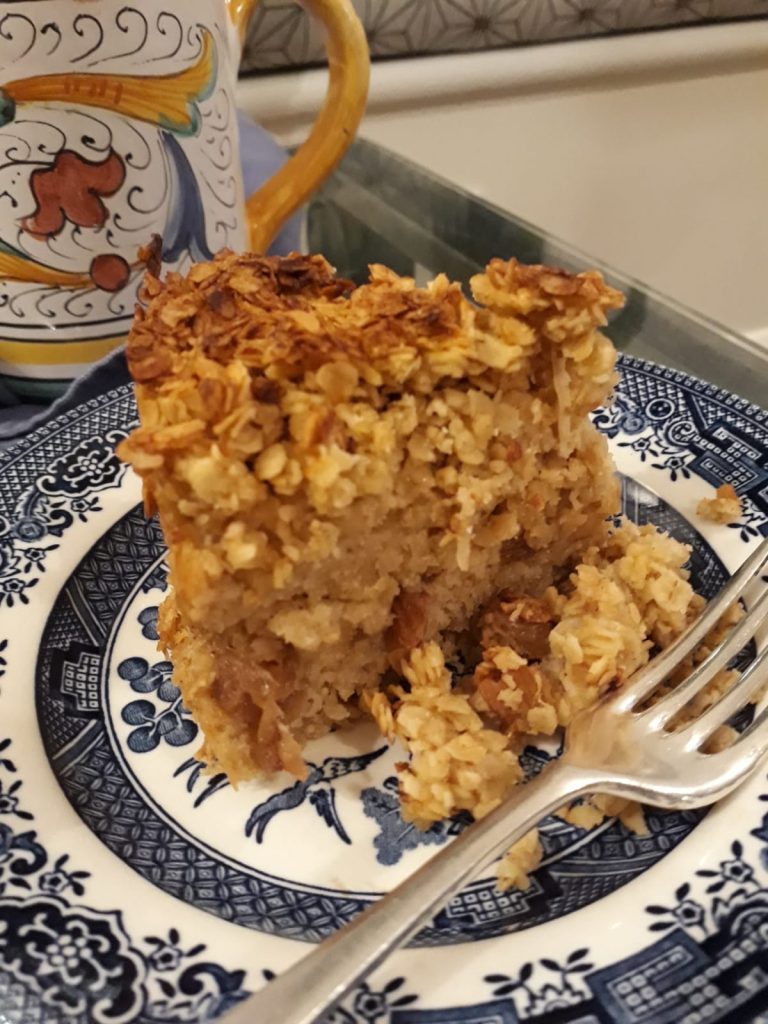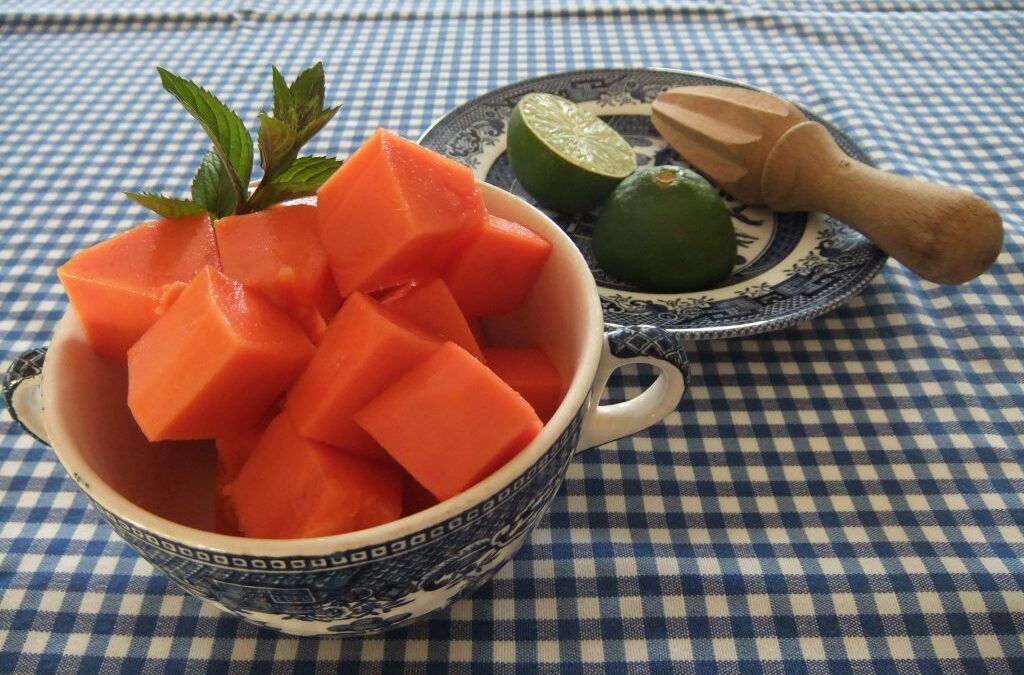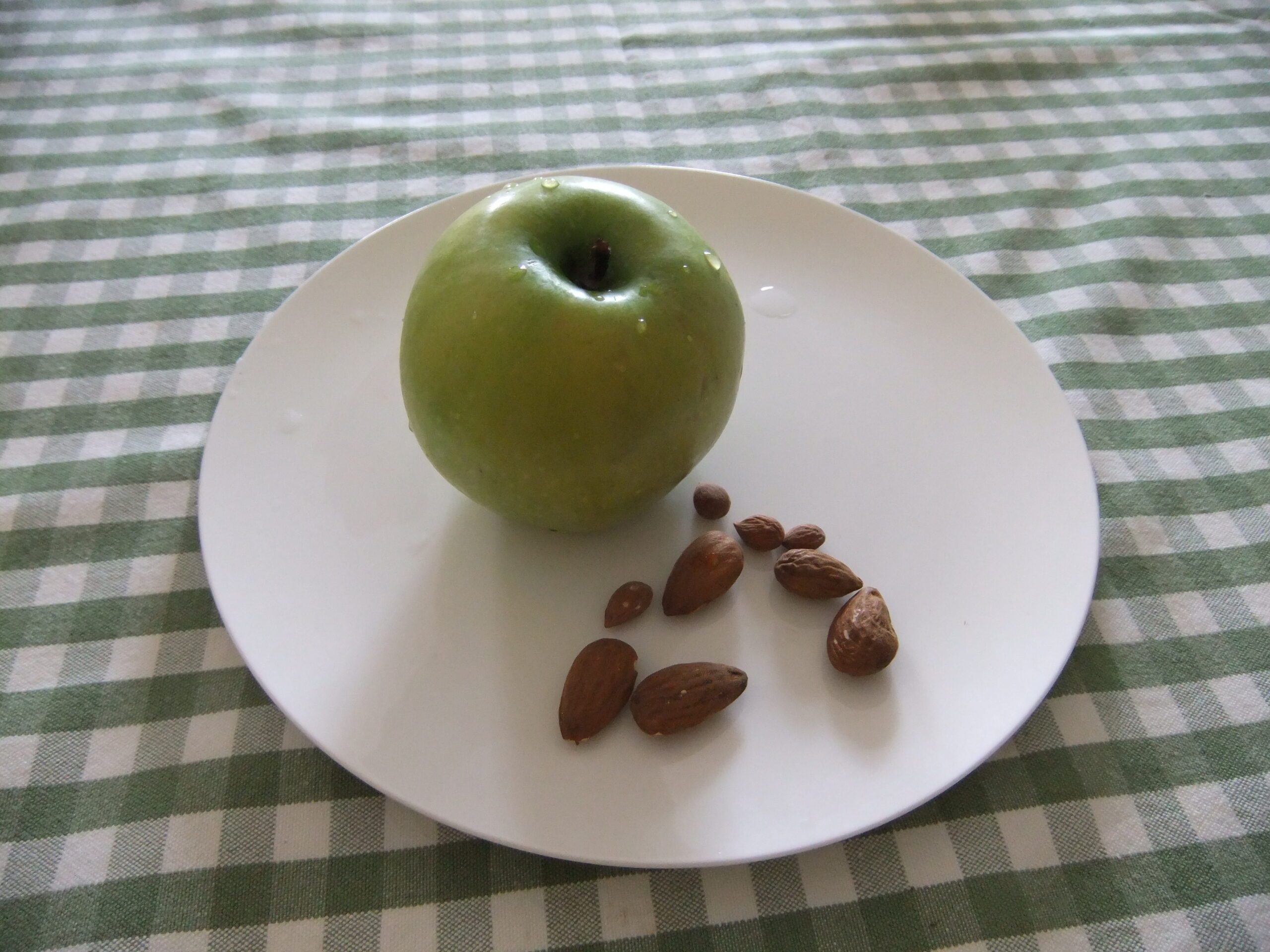
Sep 25, 2013 | Anna's Best Recipes, Desserts & drinks
We continued to use our glut of cooking apples yesterday and ate this warm out of the oven. You could use eating apples (such as French golden delicious) instead of cookers, in which case you don’t need to sweeten the apples at all. If you have one, use a food processor to blitz the oats to make the crumble super-nice. If you don’t have one, use gluten-free oat flour from the health shop (if you can eat gluten, standard oat flour is fine). You can buy miniature food processors in Argos or department stores and save yourself time and effort.
For 6 people:
1 kg cooking apples
1 tbs water
20 drops stevia (or 2 rounded tbs xylitol)
Alternatively use 1kg sweet eating apples (e.g. French golden delicious) and omit the stevia/xylitol
Optional: handful of blackberries
Remember to check out my larder & shopping section for unusual ingredients
Crumble topping:
100g (1¼ cups) gluten-free porridge oats or gluten-free oat flour (or normal porridge oats/oat flour if you can eat gluten)
50g (1/2 cup) ground almonds
40g (3 level tbs) virgin coconut oil
1-2 rounded dsp xylitol (amount depends how sweet you like the topping)
1. Into a large saucepan put 1 tbs water and 20 drops of stevia (or the xylitol). Put on a low heat to warm while you peel and slice the apples into the pan. Stir around to make sure the stevia/xylitol is evenly distributed. Cover and cook gently for around 10 minutes until the apples are softened.
2. Preheat oven to 170C (for fan oven, for non-fan oven, 185C)
3. Meanwhile make the crumble. Blitz the porridge oats in the food processor or use the gluten-free oat flour. Tip into a bowl with the ground almonds, a dessertspoon of xylitol/coconut sugar and the coconut oil. Chop the coconut oil into the mix with a knife until it resembles breadcrumbs. Taste for sweetness and, if you like, add another dessertspoon of xylitol/coconut sugar and mix around.
4. Grease a 20x30cm pyrex dish or roasting tin – a bit smaller or larger won’t matter much but this size gives you a nice depth of dessert.
5. Empty the cooked apples into the dish and flatten with a spoon. Scatter the crumble evenly over the top.
6. Cook in the oven for around 30 minutes until slightly golden.
6. Serve on its own or with one of the following:
Dairy-free: natural coconut yoghurt (e.g. Abbot Kinneys or Coyo) sweetened with a few drops of vanilla extract
Dairy: a blob of Greek yoghurt
Variations:
- Instead of 100g oats you can use 50g gluten free oat flakes and 50g buckwheat flakes, all blitzed in the food processor to a coarse flour. If you are able to eat gluten, you can also buy oat flour in health stores and use this instead. NB. Unless certified gluten-free, oats are often contaminated with wheat (gluten).
- Add a pinch of ground cloves and a teaspoon of cinnamon to the apple mixture for extra health benefits and delicious fragrance
- You could also use coconut sugar instead of xylitol for extra caramel flavour and crunch – its delicious and contains some minerals.
Why this is better for you:
Apples, especially cooking apples, are a rich source of a soluble fibre called pectin. Soluble fibres like pectin feed beneficial bacteria in your gut. Pectin binds to harmful toxins (e.g. mercury from dental fillings and tune, or arsenic from non-organic rice) in the bowel. This makes them inert and aids their excretion. Oats also contain soluble fibre. Coconut oil is a rich source of medium chain triglycerides that help boost energy rather than being stored as body fat. Unlike most other oils, coconut oil is stable at high temperatures and so is safe to use in cooking. Using pure stevia (as herb) as your zero calorie sweetener for the apples is a 100% healthy form of sweetening. Xylitol is made from birch tree sap and causes fewer spikes in blood sugar than “normal” sugar or honey. I use xylitol for the crumble as stevia didn’t really seem to sweeten the topping enough when I experimented with it. Sweeteners such as xylitol, honey, coconut sugar, molasses and maple syrup are still not actively good for you though, so sweetened foods like this dessert are best kept for occasional treats not everyday eating

Sep 18, 2013 | Anna's Best Recipes, Cakes, biscuits & bars, Desserts & drinks
These are like a cross between a cake and a flapjack and are great for lunchboxes if you feel the need to put baked treats in. You can also eat them warm, topped with a dollop of natural coconut yoghurt or (for dairy) Greek sheep’s yoghurt with a few drops of vanilla extract stirred in. For these, I adapted Theodora Fitzgibbon’s apple flakemeal layer cake recipe into a traybake and swapped butter for virgin coconut oil.
Makes 16 squares
For unusual ingredients, see “larder & shopping”.
325g cooking apples
1 rounded tsp ground cinnamon
A generous pinch of nutmeg, if you have it
30g raisins
50g virgin coconut oil (or butter, if you eat dairy)
1½ rounded tbs rounded tbs honey
1 rounded dsp blackstrap molasses
175g gluten-free porridge oats (or normal if you eat gluten)
Grated rind of an organic lemon (if you cant get organic, scrub in hot water before using)
Juice ½ lemon
1 egg
- Turn on the oven to 180C (165C fan).
- Line a 20-20cm baking tray or brownie tin with greased baking paper.
- In a large saucepan on a very low heat gently melt the honey, molasses and coconut oil. A tip for getting the honey or molasses easily off the spoon is to heat the spoon first in a jug of boiling water.
- Meanwhile chop the raisins, peel and grate the apples and mix everything together with the lemon juice and rind. The antioxidants in the lemon prevent the apples turning brown. When the oil and honey mixture is melted, add the oats, cinnamon, nutmeg, apple mixture to the saucepan and mix to combine. Finally, beat the egg, add in and mix lightly.
- Turn the mixture into the prepared tin, even out and smooth down with a knife or spatula and bake, checking after about 20 minutes. It should take around 30 minutes and be only very slightly browned on top and at the edges. It will still be moist and a little springy to the touch.
Why this recipe is better for you:
Virgin coconut oil is a healthy oil rich in medium chain triglycerides that help increase energy levels in your body and brain rather than being stored as fat in your body. Cooking apples are a very rich source of pectin, which binds to toxic materials in the bowel until they can be eliminated safely. Both apples and oats contain soluble fibre which nourishes beneficial bacteria in the gut. Beneficial bacteria help support immunity, clear skin and regulate bowel function. Honey, molasses and almost all other sweeteners are still high in natural sugars so if you want the ideal diet, aim not to eat them more than a couple of times a week. For transitioning from a high sugar to a low sugar diet though, these are ideal. Molasses is high in iron and chromium so it does have some benefits as well as its lovely toffee flavour. Stevia is the only exception to this as it contains no sugars at all and is 100% healthy.

Aug 5, 2013 | Anna's Best Recipes, Desserts & drinks
We ate this for dessert last night, and I indulged again after a full breakfast this morning so am sitting here feeling a bit stuffed! This delicious mostly cake is very decadent and has a lot of good-for-you stuff. Technically its not all raw as cashew nuts are steamed after harvesting to make them edible. You can make this up to 5 days ahead if you like. The recipe is adapted from one by Laura Wright but I have reduced the syrups and given you alternatives for those hard-to-find ingredients. I also use cooked beetroot instead of raw, which simply doesnt break up well unless you have a super high speed food processor. Sometimes I make individual servings in mousse rings and store in a box in the freezer. I find that this cake quantity makes at least 10 so sometimes I make half the quantity for a smaller gathering.
It’s really important to use the mousse ingredients at room temperature not straight from the fridge – otherwise it solidifies instantly into an un-pourable mound with a grainy texture. I found out this by experience!!
For 1 x 22cm cake (to serve 10-12):
Remember to check out “larder & shopping” section in this blog for suppliers
Base:
310g raw almonds
30g raw cacao powder
¼ level tsp Himalayan or Atlantic Sea Salt
40g dried sour cherries (or use dried cranberries if you can’t get cherries)
8 medjool dates, pitted
1 tsp vanilla extract
1 rounded tbsp extra virgin coconut oil
Mousse:
325g raw cashews, soaked overnight in filtered water, at room temperature
330ml almond milk, at room temperature
155ml/140g extra virgin coconut oil, gently warmed to a liquid
60ml/4 level tbs/85g raw honey, raw agave nectar or maple syrup, at room temperature (tip: use a hot spoon to measure honey, if using)
Juice of 1 lemon, at room temperature
2 tsp vanilla extract
¼ level tsp Himalayan or Atlantic Sea Salt
115g frozen, pitted cherries (or raspberries if you prefer), thawed, at room temperature – or use pitted fresh cherries if in season
1 small cooked beetroot, chopped, at room temperature (shop bought will do)
1 x 22cm spring-form cake tin
A little extra coconut oil for greasing the tin
A food processor
Cling film (if making ahead and storing in the freezer)
1. To make the base, place the almonds in a food processor and pulse until chopped and resembling breadcrumbs. Add the cacao powder, salt, dried sour cherries, dates, vanilla and rounded tbsp coconut oil and blitz until the dried fruit is evenly distributed throughout the mix. When the mixture holds together when pinched, it’s ready to use. Grease the sides of your tin with a little extra coconut oil or rapeseed oil. Evenly press the base mix into the bottom of the prepared tin and set aside.
2. To make the mousse, remember that all the ingredients need to be at least at room temperature or else the mix thickens too quickly and becomes grainy and unpourable. Drain the cashews and combine them in the food processor with the almond milk, coconut oil, honey/maple syrup or agave, lemon juice and salt. Blend until smooth.
3. Pour all but 500ml (about half) of the mixture into the prepared tin. Add the pitted cherries and chopped beetroot to the remaining 500ml of the mixture. Blend until smooth and pour all but 250ml of this mixture quickly into the centre of the cake. Lightly drizzle the remaining mousse mixture around the top of the cake creating a decorative marbled effect.
4. To set the mousse cake: cover the tin with a plate and place in the coldest (bottom) shelf of the fridge for 6 hours or overnight. Alternatively, stretch cling film over the top of the tin and slide gently into the freezer for 6 hours or overnight. The cake will keep quite happily for a couple of weeks in the freezer. Remove from the freezer to thaw at room temperature for 1-2 hours before serving. When its soft right the way through (test with a needle), place in the fridge until you want to serve.
Dietary note:
Virgin coconut oil is a great source of medium chain triglycerides, a special type of fat that goes straight into energy production in your body instead of being used to make fat. For this reason, it is a healthier fat than butter. Coconut oil also contains capryllic acid, which has anti-fungal properties – good news for anyone with bowel issues or cystitis linked to candida. Cherries, red berries and beetroots are high in proanthocyanadins which strengthen connective tissue and the lining of your digestive system, reducing the tendency to diverticulitis, hernias and saggy skin. Raw almonds (and cold-pressed or “extra virgin” oils) contain vitamin E. This vitamin naturally lubricates and moisturises your skin, reduces the production of wrinkles, and also helps dampen down allergic reactions. Healthy skin does not need body moisturisers. “Raw” cashew nuts are, bizarrely, not raw at all – the nuts have to be steamed in order to be extracted from their hard shell. Cashews are a sweetish and healthier substitute for cream cheese, sugar and other not-so-great ingredients that tend to be used in desserts. Desserts like this one should be used as occasional treats and not eaten at every meal. They are still rich in natural sugars and if you eat them all the time, provide more calories than you need. A normal daily intake of raw nuts and seeds would not exceed a tablespoon or two.

Aug 1, 2013 | Anna's Best Recipes, Desserts & drinks
Last night we ate scoops of this creamy, delicious banana ice piled in chilled cocktail glasses. Its incredibly simple to make but totally delicious. The recipe is adapted from one in Agnes Marshalls Book of Ices which came out in 1885. This is very sweet even when made with lemons. Children love it.
Serves 6 (allowing 2 scoops per person)
6 ripe bananas (with spots)
100g xylitol/erythritol
300ml water
The juice of 2 oranges or lemons
A blender/food processor, and (if you have it) an ice cream maker
1. If using an ice cream maker, turn it on to start chilling straight away. This takes at least 10 minutes.
2. Place all the ingredients in a food processor or blender and puree well.
3. Now either freeze the mixture or churn in an ice cream maker until solidified (this takes around half an hour). Eat immediately or store in the freezer. If you don’t use an ice cream maker, then removing the mix from the freezer after an hour and beating it with a whisk before replacing in the freezer will make it creamier. Its not vital, though.
4. To serve, remove from the freezer for half an hour to soften. If you have a metal ice cream scoop, dip it in a jug of hot water between scoops to achieve perfectly-shaped scoops (I was in a hurry, forgot to boil the kettle, and didn’t bother, which is why the photo above looks a bit too rustic…).
Why this is good for you:
Bananas are a rich source of fructo oligo saccharides (FOS for short), which help feed beneficial bacteria in your gut. Xylitol is a healthier alternative to standard sugar as appears not to deplete nutrients and has a much lesser impact on blood sugar levels. Even diabetics can eat xylitol. Fresh lemon juice is high in health-boosting antioxidants and is supportive of liver function – good news if you want to balance hormones, enhance energy or have perfect skin. If you want to avoid upsetting blood sugar levels (bananas are a high sugar fruit), eat this ice as a dessert after a protein meal or eat some protein/healthy fats alongside. A dollop of Coyo or Abbot Kinney’s dairy-free yoghurt (from health stores) would be a good thing to top this. Or sprinkle 1 tbsp of gently toated almond flakes on top before eating.

Jul 30, 2013 | Anna's Best Recipes, Desserts & drinks, Sides, starters, soups & snacks
Last weekend I craved some fresh, gorgeous, ripe papaya so we visited the Asia Market in Dublin 2 where we picked up an enormous specimen for about €7. We cut about a third off, scooped out the spherical black seeds, peeled the section with a potato peeler, and cubed it before piling it into bowls and drizzling with lime juice. The rest we kept in the fridge for the next day, and the next. A real taste of southeast Asia. This is the simplest dessert in the world after a weekday dinner. If you wanted to make this into a snack, serve a cupful of papaya pieces with a heaped tablespoon of delicious (dairy-free) Coyo coconut “yoghurt” from health stores. I get my Coyo from Ennis butchers in Inchicore who also sell great meat and fish, and from Nourish health stores.
1 ripe papaya (you will want enough to make 2 teacupfuls of bite-sized cubes)
1 lime, cut in half
1. Peel and scoop out the seeds of a piece of papaya large enough to yield 2 cupfuls
2. Pile into 2 bowls and hand around a lime half to drizzle over. Delicious.
Why this is good for you:
Papaya contains the enzyme papain, which helps digest protein. It’s often in digestive enzyme supplements. Papaya eaten as a dessert after a meal of fish, eggs, meat, or beans helps you digest the meal. Papaya also has anti-inflammatory properties and is rich in minerals.

Jul 8, 2013 | Anna's Best Recipes, Sides, starters, soups & snacks
Here’s a simple snack I used to eat 11 am to keep my concentration levels high and my energy up until lunch. When my health improved I was able to drop the snacks. Many of my clients have issues with energy fluctuations and snacks like this help while they sort out the underlying causes. This sort of snack gives slow-burn energy – unlike coffee or sugary/starchy foods.
Why this is good for you:
Almonds are high in calcium and magnesium needed for healthy bones, resilience to stress, and much more. Apples (especially organic with the skin left on) give you quercitin, which is anti-allergy, anti-inflammatory, and anti-aging. Apples are high in soluble fibre needed to feed healthy bacteria in the gut. An apple a day really does help keep the doctor away.






